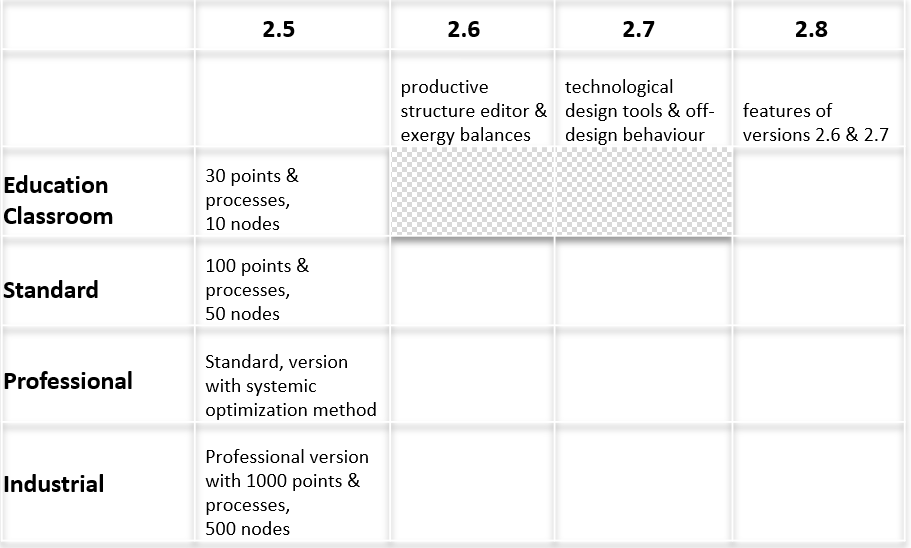Versions are firstly characterized by a label that defines the features, detailed below:
- Demo version
- Education Classroom version (éducation Salle de cours in French)
- Standard version
- Professional version
- Industrial version
and secondly by a serial number (2.5x, 2.6x, 2.7x or 2.8x), which represents the chronological development of the software.
Numbers 1.3 to 1.7 were Thermoptim versions using old Java libraries (JRE or JDK 1.1.8). They are no longer maintained or marketed.
Numbers 2.51 to 2.81 and 2.52 to 2.82 are Thermoptim versions requiring Java 2 libraries (JRE or JDK 1.3 and above).
The change in Java environment was indeed a necessity because the old libraries are no longer maintained and are not available for all operating systems. For example, the Mac OS X does not provide them.
The "phenomenological" version officially distributed is version 2.52, while version 2.51 continues to be available.
Versions 2.61 and 2.62 provide access to the editor of productive structures which, among other things, allows one to automate the establishment of exergy balances.
Versions 2.71 and 2.72 are the ones that include technological design tools and off-design features .
Versions 2.81 and 2.82 provide access to the editor of productive structures which, among other things, allows one to automate the establishment of exergy balances, and includes technological design tools and off-design features.
This table summarizes the main differences between these versions. You will find more details in the rest of this page.

Since May 2021, we have released in the guided explorations the new demo version 2.82 of Thermoptim which gives access to some advanced features of the software package that allow one to work on topics hitherto reserved for higher versions. All Thermoptim users can thus learn how to calculate the surface of a heat exchanger, establish exergy balances thanks to the productive structures and implement the pinch method. From the beginning of 2022, all new versions 2.52 to 2.82 are released. In terms of features of the software package, they differ from previous versions (2.51 to 2.81) essentially by additional developments concerning on the one hand the exergy balances, with in particular a better calculation of the exergy of moist gases, and on the other hand the technological design and off-design operation, with in particular the addition of new correlations for the calculation of pressure drops and heat exchange coefficients during two-phase exchanges in evaporators and condensers. On the IT side, they take into account a change in Java libraries that occurred in 2018, which forced us to modify Thermoptim's as well as external classes' code. For this reason, although they can still load the .prj project and .dia diagram files read by previous versions, the external classes they use are no longer compatible with the old ones. Their extThopt2.zip and extUser2.zip files are different, and the external classes of the model library have been supplemented to take this peculiarity into account. During a transition period whose duration is not yet set, the new versions and the previous ones will be distributed in parallel, but the latter are no longer maintained and are destined to disappear in the long run.
A Thermoptim demo version is freely distributed to allow you to view existing projects and diagrams, and to build small ones in order to familiarize yourselves with the tools. Of course it does not provide access to all the software features. Although it enables the loading of a project of a size exceeding the limits below, the number of points or processes that can be created is limited to 10 and that of nodes to 5. The charts can only be used to passively view the cycles constructed in the simulator, because their interactivity and access to the cycle editor are removed. Diagnostic tools, monitoring of the automatic recalculation (and the set pressures), sensitivity analysis and optimization are not available, and only certain substances are available. In addition, it does not allow you to save projects or diagrams, nor the output result files.
The new demonstration version 2.82 gives access to certain advanced functionalities of the software package which allow working on subjects hitherto reserved for higher versions: All Thermoptim users can thus learn how to calculate the area of a heat exchanger, how to establish exergy balances thanks to the productive structures and how to implement the pinch method. Like the previous one, this demo version does not allow you to save diagrams and projects, but it opens all the working files of the software package.
The Thermoptim Education Classroom version allows you to view existing projects and diagrams, and to build them. It does not give access to all the software features. Although it enables the loading of a project of a size exceeding the limits below, the number of points or processes that can be created is limited to 30 and that of nodes to 10. The charts can only be used to passively view the cycles constructed in the simulator, because their interactivity is removed and access to the cycle editor is limited. Diagnostic tools, monitoring of the automatic recalculation (and the set pressures), sensitivity analysis and optimization are not available, and only certain substances are available (see list below). Unlike the trial / demo version, it allows you to save the projects, diagrams and output result files. From version 2.51, it includes the external class manager which allows you to add or remove external classes in or from the extUser2.zip file. Vapors Pure ideal gas
Education Classroom Version, with the systemic optimization method
Full version with 100 points and processes, 50 nodes, without the systemic optimization method Vapors Pure ideal gas
Full version with 100 points and processes, 50 nodes, with the systemic optimization method
Full version with 1000 points and processes, 500 nodes, with the systemic optimization method


